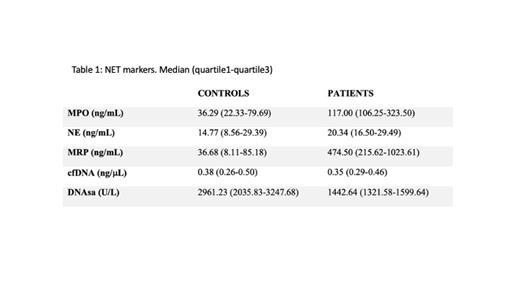Abstract

Background : The SARS-CoV-2 infection activates both innate and adaptive immune responses and induces an exaggerated cytokine storm leading to causes septic shock, acute respiratory distress syndrome, and/or multiple organ failure in critically ill patients. The knowledge of this dysregulated immune response is not well explained. One hypothesis is that the response of macrophages and neutrophils to infection is disproportionate, resulting in overproduction of cytokines and activation of neutrophils leading to the most severe complications of infection, including the production of multiple microthrombi and endothelial damage. Aim of the study: To evaluate the activation levels of macrophage biomarkers as well as indicators of the development of neutrophil extracellular traps (NET) in the first phase of infection in hospitalized patients with COVID19. Patients and Methods: We selected dry blood spot from a total of 60 previously identified SARS-CoV-2 infected subjects. Plasma samples were provided by the Aragon Health System Biobank's collection and were extracted within 5 days of symptom onset. Plasma from 60 healthy controls were used to stablish the control range for NETosis determination. The study was authorized by the Ethics Committee of the Aragon Health System and complies with the European General Data Protection Regulation (GDPR 2016/679) and LO 3/2018. Demographic characteristics, clinical manifestations, follow-up during hospitalization, associated comorbidities, and thrombotic complications were obtained from the database. Chitotriosidase activity (ChT), YKL40 chitinase and CCL18/PARC cytokine were measured as markers of macrophage activation. Myeloperoxidase (MPO), Neutrophil Elastase (NE), and S100A8/S100A9 Heterodimer (MPR) were immuno-quantified, levels of circulating free DNA (cfDNA) were measured as well as the presence of DNAsases by fluorimetry as indicators of Netosis. For the comparative analysis, we stratified patients by age groups and disease severity and used the Mann-Whitney U test for statistical comparison, considering a p-value < 0.05 as statistically significant. Results : A statistically significant increase in ChT (p=0.032) and CCL18/PARC (p=0.0001) was observed in the patients´ group. A comparative study with clinical variables and other inflammation markers as ferritin, D-dimer will be shown upon acceptance. Concerning NET markers, we found a statistically significant increase in MPO, NE, and MRP in COVID-19 patients (p=0.0001; p=0.0290; p=0.0001 respectively), as well as a statistically significant decrease in DNAsa (p=0.0001). No differences in cfDNA levels were observed. The table shows the median (quartile1-quartile3) for each marker in the control group and in the patient group. Conclusions : In this study, biomarkers of macrophage activation do not appear to be more sensitive than the indicators of inflammation in routine clinical practice (ferritin, D-dimer). Clinical cases of severe COVID-19 disease show an excessive NET formation, which contributes to vascular damage and the development of thrombosis.
This work was supported by a research grant from FEETEG
No relevant conflicts of interest to declare.
Author notes
 This icon denotes a clinically relevant abstract
This icon denotes a clinically relevant abstract


This feature is available to Subscribers Only
Sign In or Create an Account Close Modal